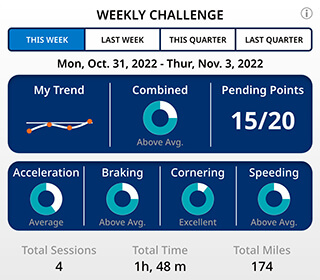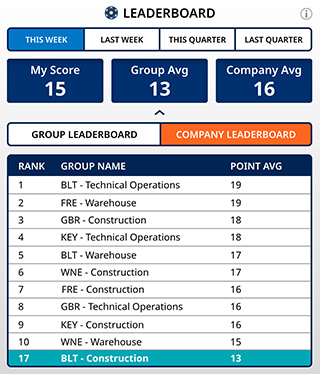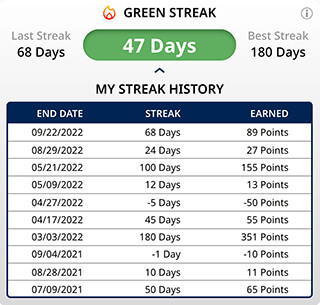Today’s fleet leaders navigate a difficult balance: On top of the complex logistics of managing fleets, they deal with the arguably more complex issue of people. Fleet leaders need to take driver skill and safety seriously, yet consider driver satisfaction – and retention. What are some creative ways to maintain safety standards while showing drivers appreciation and keeping them engaged and committed? Gamification is a creative and effective tool.
The Landscape of Driver Coaching and Correcting
First, let’s zoom out to consider the context of driver coaching. Drivers work hard for the company, and often, that translates to driving hard. When drivers are not paying for the gas, tires, or maintenance, the vehicle is treated as a tough tool to get the job done. Unfortunately, that has consequences to the lifecycle costs of the vehicle, shortening vehicle life and wearing down tires, brakes, resale value, etc.
Less obvious are the brand issues. When communities see a company vehicle, and the bumper is damaged, it reflects badly on the company. How do you take somebody who’s working hard for the company and tactfully say, “but while you’re working hard, when you’re driving, we want you to drive gently”? How do you get them to stay compliant with speed, braking, corner handling – and all of these behaviors that affect fuel economy, tires, brakes, and lifecycle costs?
There are a couple of schools of thought. One is to reward drivers financially. For instance, you could monitor a driver through telematics, generating a score and allocating additional dollars. Or it could work the opposite way where employees are not eligible for 100% of the quarterly or annual compensation package if they have had vehicle incidents.
This introduces a problem because the base expectation of a culture of safety would be that drivers do the job correctly and professionally. The hope would be that when they drive, they naturally do the right thing for the company: “Delight the customers, delight the company, and delight your coworkers. Do the job safely, because that’s our culture.” If the very baseline of behavior should be safe driving – does it make sense to compensate for meeting a basic standard? It may be counterproductive to pay employees extra to do the job correctly. Again, that goes against what one would expect from the culture that does the right thing, every job, every mile driven.
Second is continued driver training, which is standard but not a silver bullet. A manager can send someone to hours of following distance training, but if they look down at the phone, that training goes out the window the second they are distracted.
Technology helps with continued monitoring and correction, but there are lots of inherent issues with collecting data at a high level, and then trying to push it down to the local regional branch level to coach an individual. The data has to be manageable and relevant. In some cases, managers amass large amounts of administrative data that they must build scoring frameworks around and potentially combine with MVRs, safety training, historical in vehicle incidents – whether it’s on managers’ personal time or company time.
Then managers must give feedback that’s actionable. Supervisors often don’t want myriad data about a driver – to then have a contentious conversation with that driver about a vague point in time or lapse in judgment. If they are pulling a ton of data, and enough time goes by, they have lost the opportunity to provide meaningful coaching. Real time AI correction gets closer to ride-along coaching but can feel about as punitive and demoralizing as a shock collar.
The goal is to put the safest, most efficient employees behind the wheel. It requires doing all the basics – running MVRs, coaching/training programs, monitoring via telematics or cameras, and using preventative software like TRUCE. But how can you move the needle further? How can you get inside a driver’s head so that they make a different decision every single time they get behind the wheel? Gamification can be the added layer to motivate behavior change and self-correction.
Gamification for Driver Appreciation and Retention
Over a decade ago, the US government spent years and millions to reverse the growing obesity epidemic: “All of these meritorious efforts were eclipsed within 48 hours by a single video game [Pokemon] that got 40 million Americans up and walking for miles. This is the power of video games to change behavior at scale…. Video games are very good at teaching as an unintended consequence of play,” observed Level Ex CEO, Sam Glassenberg, whose company creates medical video games to educate physicians.1
Game design can be applied to driving as well, and many fleets now incorporate gamification to improve road safety, driver retention and driver appreciation.
Game Mechanic Example |
Driving Applications |
| Points: A reward system for tasks that provides positive or negative reinforcement | Gaining points for safe driving behaviors |
| Process Tracking: Shows past progress and outstanding unfinished work | Seeing a streak of exceptional driving behaviors and trying to maintain it for the rest of the week |
| Achievements: Items or badges players can show off, especially if they are rare | Getting a special badge for no harsh braking in a month |
| Loyalty: Measures daily activity | Showing compliance over a certain number of days |
| Leaderboards: Table of “winners” where users can compete against each other to become the best and get the top spot on the leaderboard | Publicly celebrating the high achieving drivers and teams to spark healthy competition |
| Loss Aversion: A fear of losing points or status is a powerful motivator to maintain good standing and continue progressing | Noticing that you didn’t do as well this week and wanting to improve your driving to get a good score again or be on the leaderboard again |
| Feedback Systems: Feedback gives players a sense of progression or accomplishment, fueling momentum and a desire to meet other milestones and achieve further results2 | Comparing your scores from day to day or week to week, creating a personal benchmark to improve on |
Research has shown that these game mechanics inspire behavior change.3 In the work environment, it can even “bring the relationship between employer and employee to a new level, which goes beyond frames of wages and [contracts] and is based on feedback, recognition, status and self-fulfillment.”4
One reason that learning and behavior change occurs is that games can evoke an emotional response that commits lessons to memory. The stronger the emotional response, the more memorable the concept. In addition, the act of playing and meeting challenges releases dopamine that leads to repeating the positive behavior.5
In the fleet space, scoring helps motivate self-correction as drivers compete against themselves. Gamification supports a culture of employee empowerment, and it removes the contentious relationship wherein the supervisor has to yell at a driver for going 85 MPH. The social element is also important. Now driver safety becomes fun. Teams earn bragging rights against other branches. It provides a way to recognize top employees, motivate other team members to do better, and provide reward opportunities through employee celebrations (meals, outings) or contests (prizes). Now drivers have everything they need to drive better and make the right decisions every day.
Examples from TRUCE’s Employee Recognition and Gamification Solution
Safe driving weekly challenges provide opportunities for driver recognition and benchmarks for personal improvement.
Leaderboards show personal, group and company average point balances, showcasing top performers.
Green streaks motivate daily compliance. Drivers gain green streak status when they consistently participate.
Driver Appreciation and Safety Culture in Action
Frank Cruice, M.S., CSP, CRSP, CHCM, CHS-1, has worked as a safety leader for over twenty years and has recently retired to become a safety consultant. He has witnessed the power of gamification to change attitudes and behaviors in the fleet industry firsthand.
“One of the most interesting experiments of my career was when I used gamification to improve driver safety,” he says. “The company was using a combination of approaches that were not quite fixing the issue: web-based continuous driver education, regular review of MVR Reports, and fleet safety technologies (in-cab cameras, vehicle collision and mitigation systems, and electronic logging). But we were still seeing an increase in rear-end and run off the road collisions, so we knew we had to get creative.”
Because those issues are commonly caused by distracted driving, they began using TRUCE’s distracted driving solution and gamification. Leveraging driver scoring in TRUCE’s app, they experimented with game formats to drive engagement. First, they successfully ran a March Madness style bracket in which associate drivers competed as teams. At the end of the competition, 90% of the groups (20 teams) improved their scores from start to finish.
To continue the momentum, he implemented a strategy to include a longer period of competition and more of a focus on individual improvement. This time they launched a six-month competition where each driver saw only their score on a weekly basis. Then they rolled up the team scores monthly and shared with the leadership and within team meetings. There were individual prizes throughout the competition with the winning team receiving a trophy to exhibit for six months until the next round of competition.
Ultimately, drivers enjoyed the experience. Towards the end they became even more competitive, reaching for the win. This contributed to team building while improving driving scores, and it inspired drivers to take individual ownership over their own safe driving practices.
A Game Changer for Driver Retention and Appreciation
Studies have shown that some of the reasons employees quit include not having the ability to advance, a poor relationship with manager and/or feeling disrespected, and poor company culture.6 Incorporating gamification into fleet safety helps combat some of these common reasons that damage driver retention.
Gamification provides a structure that allows the best drivers to be recognized regularly, formally, and easily. This driver appreciation format could impact a career trajectory, allowing those star employees to get more visibility and advancement opportunities. Supervisors then know the drivers they want to train or mentor new employees and who to promote. It provides a positive environment to make the great employee even more exceptional, i.e.: “Here’s what I’d like to see you do by the end of this month. I really want that promotion. Well, part of what I need you to do is make sure this other dimension is also hitting it out of the park.”
The teamwork also cultivates a stronger connection to coworkers, supervisors and the company overall. This cultural approach is positive and competitive, and empowering employees to do the right thing, as opposed to capturing, “spying,” and yelling. Companies that empower employees are the companies people want to work for, especially in this world right now where employees are fluid.
Cruice agrees, “During these competitions, I saw true camaraderie among team members and genuine mentoring relationships between leadership and drivers. And best of all their relationship to safety is now a lifelong one. That’s a game that everybody wins.”
- Video Games: Changing Work, Medicine, and Behavior at Scale
- Effect of Gamification on Education and Learning; 8 Examples of Game Mechanics used within Gamification
- Effect of Gamification on Education and Learning
- Usage of Gamification Theory for Increase Motivation of Employees
- New mobile games aim to help medical professionals treat coronavirus, Mesolimbic Dopamine Signals the Value of Work, The neuroscience of play: What medical device companies can learn from video games, Spark Curiosity & Deepen Understanding Through Exploratory Learning
- 12 Reasons Employees Quit (and How to Prevent It), Top 10 reasons why employees leave (and what to do about it), 9 Reasons Your Best Employees Are Quitting




